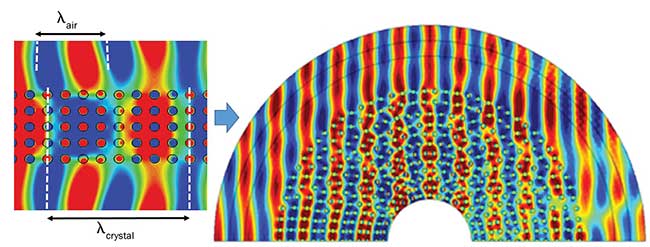Greek mythology is filled with references to an “invisibility cap” worn on occasion by Hades, Hermes and Athena that gave the wearer the power to become invisible. And today, legions of movie-goers are familiar with the title character of the Harry Potter series donning an “invisibility cloak” for all sorts of mischief.
Yet despite being the stuff of fiction, researchers have been intrigued with developing a real-world version of an invisibility cloak that would have all sorts of viable uses, from allowing pilots landing a plane to turn the cockpit floors transparent or surgeons who could use this form of optical camouflage to see through their hands and instruments during surgery.

A light wave moves faster in a photonic crystal than in air, and passes through the cloaked object. Courtesy of Elena Semouchkina, Michigan Technological University.
A research team from Michigan Technological University (MTU) is one step closer to “building” a cloak of invisibility with the help of photonic crystals.
Initially, to create such a cloak, researchers turned to metamaterials — synthetic composite materials that exhibit properties not usually found in natural materials, especially a negative refractive index. However, the resonant nature of metamaterials made the invisibility phenomena difficult since they require homogenization and experience inter-resonator coupling.
Dielectric photonic crystals, with inherent insulating properties, can be made practically lossless up to optical frequencies. They promise wider bandwidth, are free from homogenization and coupling problems, and allow for spatial dispersion of the cloak medium, which is required for accurate wave manipulation. In short, the waves move faster in the dielectric photonic crystal than in air, and the waves pass through the cloaked object, creating the illusion of invisibility.
 Elena Semouchkina, MTU associate professor of electrical and computer engineering and adjunct professor at Pennsylvania State University, and her team discovered that by varying the size of the dielectric atoms in crystals and their permittivity — the measure of how an electric field affects and is affected by a dielectric medium — superluminal phase velocities of waves can be achieved. Simply stated, the waves will move faster than the speed of light.
Elena Semouchkina, MTU associate professor of electrical and computer engineering and adjunct professor at Pennsylvania State University, and her team discovered that by varying the size of the dielectric atoms in crystals and their permittivity — the measure of how an electric field affects and is affected by a dielectric medium — superluminal phase velocities of waves can be achieved. Simply stated, the waves will move faster than the speed of light.
“By adjusting the lattice constants in such crystals properly, it is possible to control their refractive indices in a wide range. Then, building the cloak medium from fragments of crystals with various lattice constants can be used for obtaining spatial index dispersion requested by the transformation optics for cloaks,” said Semouchkina.
In her work, she has used metamaterials composed of dielectric materials. Later, she took another approach to cloaking objects using multilayer coatings formed from ordinary dielectrics. Semouchkina even proposed a cloak composed of specially designed dielectric lenses. She has found that “incorporation of dielectric photonic crystals can make devices with superior functionalities a reality at frequencies ranging from microwaves to optics.”
Semouchkina’s next goal is to work out an approach for reliable anisotropy control — the variable behavior of propagating waves in different directions — in engineered photonic crystal media. Her team also plans to extend the approaches to a larger class of devices using transformation optics.
While the idea behind invisibility cloaks remains a magical entity, science suggests it can be done by simply controlling and manipulating the flow of light.
Now you see me, now you don’t.